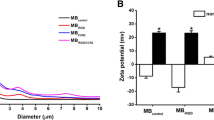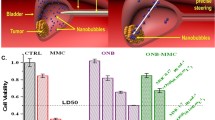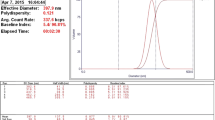Abstract
Background
The CD-TK double suicide gene has become an effective therapy for bladder cancer. A novel molecular-targeted ultrasound (US) method has been developed to precisely guide nanobubbles loaded with this gene to regions within bladder tumor cells and is widely used due to its efficiency in delivering drugs to the target tumor.
Methods
Uniform nanoscaled nanobubbles loaded with CD-TK double suicide gene were developed using a thin-film hydration sonication, carbodiimide chemistry approaches, and electrostatic adsorption methods.
Results
In the present study, we synthesized CD-TK double suicide gene-loaded cationic nanobubbles conjugated with anti-VEGFR2 that can bind with VEGFR2-positive cells. Fluorescence and flow cytometry evidence show that CD-TK double suicide gene-loaded nanobubbles were successfully developed. CD-TK-CNBs delivered via US-mediated nanobubble destruction (UMND) enhanced transfection efficiency, overexpression of CD-TK double suicide gene, and tumor cell apoptosis, and inhibited tumor cell growth in vitro.
Conclusions
These CD-TK-CNBs may become a novel treatment for bladder cancer.







Similar content being viewed by others
Availability of data and materials
Materials are available upon request.
Abbreviations
- UMND:
-
Ultrasound-mediated nanobubble destruction
- CD:
-
Cytosine deaminase
- US:
-
Ultrasound
- 5-FC:
-
5-Fluorine cytosine
- TK:
-
Thymine kinase gene
- GCV:
-
Ganciclovir
- DPPC:
-
1,2-Dipalmitoyl-sn-glycero-3-phosphocholine
- (DSPE-PEG 2000)-COOH:
-
Carboxyl-modified1,2-distearoyl-sn-glycero-3-phosphoetha-nolamine
References
Amer MH (2014) Gene therapy for cancer: present status and future perspective[J]. Mol Cell Ther 2:27
Bruix J, Gores GJ, Mazzaferro V (2014) Hepatocellular carcinoma: clinical frontiers and perspectives. Gut 63:844–855
Brujan EA (2004) The role of cavitation microjets in the therapeutic applications of ultrasound. Ultrasound Med Biol 30(3):381–387
Cao HQ, Meng XM, Liu DQ et al (2004) Killing effect of coexpressing cytosine deaminase and thymidine kinase on rat vascular smooth muscle cells [J]. Chin Med J (Engl) 117(10):1464–1470
Carrio M, Visa J, Cascante A et al (2002) Intratumoral activation of cyclophosphamide by retroviral transfer of the cytochrome P450 2B1 in a pancreatic tumor model. Combination with the HSV-tk/GCV system. J Gene Med 4:141–149
Celli JP, Spring BQ, Rizvi I et al (2010) Imaging and photodynamic therapy: mechanisms, monitoring, and optimization. Chem Rev 110(5):2795–2838
Chen ZY, Sun XF, Liu JQ et al (2012) Augmentation of transgenic expression by ultrasound mediated liposome nanobubbles destruction [J]. Mol Med Rep 5:964–970
Chen MC, Lee CF, Huang WH et al (2013) Magnolol suppresses hypoxia-induced angiogenesis via inhibition of HIF-1α/VEGF signaling pathway in human bladder cancer cells. Biochem Pharmacol 85(9):1278–1287
Chen MC, Hsu WL, Chang WL et al (2017) Antiangiogenic activity of phthalides-enriched Angelica Sinensis extract by suppressing WSB-1/pVHL/HIF-1α/VEGF signaling in bladder cancer. Sci Rep. 7(1):5376
Cheng K, Sano M, Jenkins C et al (2018) Synergistically enhancing therapeutic effect of radiation therapy with radiation activatable and reactive oxygen species-releasing nanostructures. ACS Nano 12(5):4946–4958
Chira S, Jackson CS, Oprea I et al (2015) Progresses towards safe and efficient gene therapy vectors [J]. Oncotarget 6:30675–30703
Du L, Jin Y, Zhou W, Zhao J (2011) Ultrasound-triggered drug release and enhanced anticancer effect of doxorubicin-loaded poly (d, l-lactide-co-glycolide)-methoxy-poly(ethylene glycol) nanodroplets. Ultrasound Med Biol 37:1252–1258
Fischer U, Steffens S, Frank S et al (2005) Mechanisms of thymidine kinase/ganciclovir and cytosine deaminase/5-fluorocytosine suicide gene therapy-induced cell death in glioma cells [J]. Oncogene 24:1231–1243
Hayashi S, Mizuno M, Yoshida J et al (2009) Effect of sonoporation on cationic liposome mediated IFN beta gene therapy for metastatic hepatic tumors of murine colon cancer [J]. Cancer Gene Ther 16:638–643
Heath JR, Davis ME (2008) Nanotechnology and cancer. Annu Rev Med 59:251–265
Horie T, Nishino T, Baba O et al (2009) MicroRNA-33 regulates sterol regulatory element-binding protein 1 expression in mice. Ultrasound Med Biol 35(5):847–860
Hu C, Zhang R, Jiang D (2019) TMEM16A as a potential biomarker in the diagnosis and prognosis of lung cancer. Arch Iran Med. 22(1):32–38
Karshafian R, Bevan PD, Williams R et al (2009) Sonoporation by ultrasound-activated microbubble contrast agents: effect of acoustic exposure parameters on cell membrane permeability and cell viability. Ultrasound Med Biol 35(5):847–860
Li XH, Zhou P, Wang LH et al (2012) The targeted gene (KDRP-CD/TK) therapy of breast cancer mediated by SonoVue and ultrasound irradiation in vitro [J]. Ultrasonics 52:186–189
Li J, Zhou P, Li L, Zhang Y et al (2016) Effects of cationic nanobubbles carrying CD/TK double suicide gene and αVβ3 integrin antibody in human hepatocellular carcinoma HepG2 cells [J]. PLoS One 11:e0158592
Lv Y, Cao Y, Li P et al (2017) Ultrasound-triggered destruction of folate-functionalized mesoporous silica nanoparticle-loaded microbubble for targeted tumor therapy. Adv Healthc Mater 6(18):1700354
Obrien T, Cranston D, Fuggle S et al (1995) Different angiogenic pathways characterize superficial and invasive bladder cancer. Cancer Res 55:510–513
Pahle J, Walther W (2016) Vectors and strategies for nonviral cancer gene therapy [J]. Expert Opin Biol Ther 16:443–461
Park H, Yang J, Lee J, Haam S et al (2009) Multifunctional nanoparticles for combined doxorubicin and photothermal treatments. ACS Nano 3(10):2919–2926
Shang H, Wu B, Liang X et al (2019) Evaluation of therapeutic effect of targeting nanobubbles conjugated with NET-1 siRNA by shear wave elastography: an in vivo study of hepatocellular carcinoma bearing mice model. Drug Deliv 26(1):944–951
Siegel R, Naishadham D, Jemal A (2013) Cancer statistics, 2013. CA Cancer J Clin 63:11–30
Tang Q, He X, Liao H et al (2012) Ultrasound nanobubbles contrast agent-mediated suicide gene transfection in the treatment of hepatic cancer [J]. Oncol Lett 4:970–972
Vago R, Collico V, Zuppone S et al (2016) Nanoparticle-mediated delivery ofsuicidegenesin cancertherapy. Pharmacol Res. 111:619–641
Verma A, Degrado J, Hittelman AB et al (2011) Effect of mitomycin C on concentrations of vascular endothelial growth factor and its receptors in bladder cancer cells and in bladders of rats intravesically instilled with mitomycin C. BJU Int 107(7):1154–1161
Wang Y, Zhou K, Huang G et al (2014) A nanoparticle-based strategy for the imaging of a broad range of tumours by nonlinear amplification of microenvironment signals. Nat Mater 13:204–212
Wilhelm S, Tavares AJ, Dai Q et al (2016) Analysis of nanoparticle delivery to tumours. Nat Rev Mater. 1:16014
Wirth T, Ylä-Herttuala S (2014) Gene therapy used in cancer treatment. Biomedicines 2(2):149–162
Wirth T, Parker N, Ylä-Herttuala S (2013) History of gene therapy [J]. Gene 25:162–169
Wood AK, Sehgal CM (2015) A review of low-intensity ultrasound for cancer therapy [J]. Ultrasound Med Biol 41:905–928
Wu M, Wang Y, Wang Y et al (2017) Paclitaxel-loaded and A10-3.2 aptamer-targeted poly(lactide-co glycolic acid) nanobubbles for ultrasound imaging and therapy of prostate cancer [J]. Int J Nanomedicine 12:5313–5330
Wu M, Zhao H, Guo L et al (2018) Ultrasound mediated nanobubble destruction (UMND) facilitates the delivery of A10-3.2 aptamertargeted and siRNA-loaded cationic nanobubbles for therapy of prostate cancer. Drug Deliv 25(1):226–240
Xu Y, Xie Z, Zhou Y et al (2015) Experimental endostatin-GFP gene transfection into human retinal vascular endothelial cells using ultrasound-targeted cationic nanobubbles destruction [J]. Mol Vis 21:930–938
Yang J, Su H, Sun W et al (2018) Dual chemodrug-loaded single-walled carbon nanohorns for multimodal imaging-guided chemo-photothermal therapy of tumors and lung metastases. Theranostics 8(7):1966–1984
Yoshimura I, Suzuki S, Tadakuma T et al (2001) Suicide gene therapy on LNCaP human prostate cancer cells. Int J Urol 8:S5–S8
You HB, Park K (2011) Targeted drug delivery to tumors: myths, reality and possibility. J Control Release 153:198–205
Zarogoulidis P, Darwiche K, Sakkas A et al (2013) Suicide gene therapy for cancer–current strategies [J]. J Genet Syndr Gene Ther 4:16849
Zhou S, Li S, Liu Z et al (2010) Ultrasound-targeted nanobubbles destruction mediated herpes simplex virus-thymidine kinase gene treats hepatoma in mice [J]. J Exp Clin Cancer Res 29:170
Zhou SJ, Li SW, Wang JJ et al (2012) High-intensity focused ultrasound combined with herpes simplex virus thymidine kinase gene-loaded ultrasound-targeted nanobubbles improved the survival of rabbits with VX2 liver tumor [J]. J Gene Med 14:570–579
Acknowledgements
This study was approved by The Animal Ethics Committee of Chongqing Medical University and the ARRIVE guidelines followed for the welfare of the animals.
Funding
The present work was sponsored by the National Science Foundation of China No. 81650003, Research on the Frontiers and Application of Chongqing Science and Technology Commission No. cstc2015jcyjA10030, Key Medical Scientific Research Project of Chongqing Municipal Health department No. 2012-1-037, and the Science and Technology Project of Chongqing Yuzhong District No. 20130117, Project of Science and Technology Innovation Foundation of Zhongnan Hospital of Wuhan University No. znpy2018021.
Author information
Authors and Affiliations
Contributions
CH and RG Z conceived of and designed the study. CH, MW, JW, and DP J performed the experiments. CH, JW, and RG Z analyzed and interpreted the data. CH wrote the manuscript. RG Z and JW revised the paper. All authors read and approved the final manuscript.
Corresponding author
Ethics declarations
Conflict of interest
All authors declare that they have no conflicts of interest.
Additional information
Publisher's Note
Springer Nature remains neutral with regard to jurisdictional claims in published maps and institutional affiliations.
Rights and permissions
About this article
Cite this article
Hu, C., Jiang, D., Wu, M. et al. Ultrasound-mediated nanobubble destruction (UMND) facilitates the delivery of VEGFR2-targeted CD-TK-loaded cationic nanobubbles in the treatment of bladder cancer. J Cancer Res Clin Oncol 146, 1415–1426 (2020). https://doi.org/10.1007/s00432-020-03160-7
Received:
Accepted:
Published:
Issue Date:
DOI: https://doi.org/10.1007/s00432-020-03160-7




